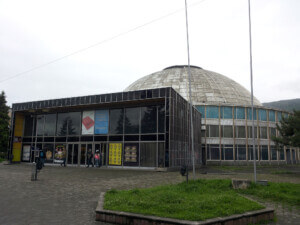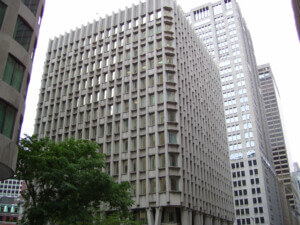When Nathan J. Robinson, J.D. starts talking about architecture, people listen. Founder and editor-in-chief of the publication Current Affairs, a trained legal scholar and sociologist, and one very snappy dresser, Robinson is a leading light in what has been described as the “nice-bag left”—a kinder, gentler anti-capitalist dispensation advancing a vision of socialism not just with a human face, but with a sexy bod to go with it. “The socialist project is not just to create better living standards, but to create collective joy,” Robinson has written. In a discursive climate full of gloomy critique and fulminous dissent, the Current Affairs bunch just wants to let the sunshine in.
Attitudinally, this is rather a daring thing to bring to architecture, which in addition to being inhabited by a lot of very self-serious persons tends to be hyper-vigilant in its gatekeeping. The only two things that critics, practitioners, and design-watchers of all kinds can generally agree on are (1) not enough non-specialists talk about architecture, and (2) any non-specialist who is talking about architecture is invariably wrong. This bait-and-switch has ensnared “inquiring” minds from Norman Mailer to Alain de Botton to Prince Charles; so when Nathan Robinson joined the fray—beginning in a 2017 article, then last month in a piece entitled “When Is the Revolution in Architecture Coming?”—it wasn’t surprising that his reception was rather frosty, at least as gauged by online chatter and (always a more accurate barometer of archi-world sentiment) things overheard at weekend social functions.
In substance, Robinson’s take boils down to an aesthetic gripe of the kind occasionally labeled “populist,” presuming as it does that there are varieties of buildings that people very much want and that architects, abetted by a dour critical establishment, stubbornly refuse to give them. “Nearly everything being built is boring, joyless, and/or ugly,” the writer maintains, and then proceeds to inveigle on behalf of “color” and “warmth” and “human scale.” Defending the latter values, Robinson proffers such varied examples as medieval Hindu temples and assorted flavors of expressionist futurism, even going so far as to heap praise on Amazon’s much-ridiculed crystal-ziggurat headquarters proposal. Here, we understand, is a left critic determined to surprise, capable of evincing at least some appreciation for the sort of showy architectural spectacle usually associated with the neoliberal elite, as well as for the traditional stylings more frequently favored on the political right. Let a thousand flowers bloom, Robinson says—except of course for the flowers he doesn’t like, which appears to include most of modernism, anything he perceives as Brutalist, presumably quite a lot of the more austere Romanesque and Gothic and probably some of the less jazzy Deco as well.
Trouble is, kvetching about this stuff is only to fall into Robinson’s rhetorical trap. De gustabis, as we all know, non est disputandum, and by so flagrantly disputand-ing all this gustabis Robinson invites precisely the kind of killjoy, get-off-our-lawn, hippy-punching response from the discipline that he is mocking architecture for in the first place. Furthermore, who the hell doesn’t like expressionism, or the muqarnas of the Shah Mosque (helpfully identified by Robinson as simply “Islamic architecture”), or punky, magpie ad hoc-ism? I love it. So do you. As far as taste goes, the Current Affairs hetman is on fairly solid ground—notwithstanding the timeless monuments that he would evidently consign to the ash heap, though presumably the Landmarks Preservation Commission will have something to say about that. No, the problem with Robinson is not that he doesn’t know what he’s talking about. The problem is his politics. And that he mostly doesn’t know what he’s talking about.
What Robinson is pushing, ideologically, is utopianism—the world made whole, not in some flat or sterile way as the milquetoasts meliorists of architecture would have it, but in a broadly-shared ecstasis of everyday life. What he doesn’t know, it seems, is that he is far from the first to suggest this as a lodestar for architectural practice. With the exception of some hat-doffing to the lyrical humanist buildings of Christopher Alexander, Robinson’s view of recent design history is painfully blinkered, especially towards the one period that ought to be of the greatest interest to him: the 1960s, a decade that saw the most recent and most intense bout of utopian enthusiasm in architecture, but that Robinson associates more or less solely with Brutalism (and that only of the most leaden, police-station-and-tunnel-ventilation-shaft description). Neither the technological arabesques of Archigram, nor the post-capitalist funkiness of Constant Nieuwenhuys, nor the desert-freak mud castles of Arcosanti intrude upon the writer’s argument.
In fact, it may upset Robinson to learn that Brutalism itself sprang from the same groovy soil as the above; as conceived by pioneers like Alison Smithson, those concrete shells were intended merely as “supportive places [for] human interaction,” their ostensible neutrality making them infinitely moldable to whatever uses their occupants might dream up. Festooned (in many of the original drawings) with plant life, decked with such banners and murals as people might drape and paint over the walls, Brutalist buildings were modern-day caves for a new form of quasi-primeval, communal life. As a place to live, Lascaux might be a bit damp, but it wouldn’t be boring to look at.
Trace this line a bit further, and it becomes clear how Robinson ends up in a bad spot. It’s significant that, in a brief postscript, he attempts to proof his essay against what he plainly recognizes is a political weak point: “we cannot change our design until we change our economic system,” he says. Right on—but there’s worse news from the historical front. Those avowedly utopian architectural movements, Brutalism among them, didn’t just falter or founder because they were undermined or coopted by capital (though that sure as hell helped); they did so because utopian politics makes a uniquely rotten pairing with architecture. The most beautiful buildings leak, the most playful ones break. Be it ever so ludic or grand, teeming in filigree or bristling in ornament, someone will declare a building is hideous, someone else will spray paint a rude word on it, and someone else will discover the bathroom is a living shrine to every smell ever conceived there.
In its lack of autonomy, in its concessions to techne and to social utility, architecture is twisted at the root, and though many magnificent things may grow from it nothing straight ever will. This is alright, most of the time, at least until you start asking for Nathan Robinson-levels of enjoyment and fulfillment. While he recognizes how far off the coast of Utopia remains, Robinson still leads with his utopian impulse, setting architecture up for the most precipitous kind of fall. And when the revolution inevitably comes, when the world is at last filled with the wonderful, dysfunctional, colorful, horrid buildings of Robinson’s imaginings, the critical tendency will be to discredit his whole political project.
To be clear, that would not be a good thing. “The future will be utopian or there will be no future,” as Slavoj Žižek has said. We can reserve judgment as to the perfectability of humankind, but without some attractive social objective in mind, it is impossible to take one’s ethical bearings. And Robinson is right—unless designers can consistently and loudly make the case for an architecture as sensitive to desire as to need, they will have to cede the former to the builders of theme parks and the movie studios who pay for them. (Full disclosure: I love theme parks. So do you.) But in the pursuit of our architectural pleasures, we might take care to occasionally glance over our shoulders, and to worry. We might even ask, at the risk of sounding like one of Robinson’s stick-in-the-mud straw men, whether architecture itself might be capable of articulating that worry: whether, alongside its duties and its joys, a building might also have a critical life of its own. What would it say about us?










